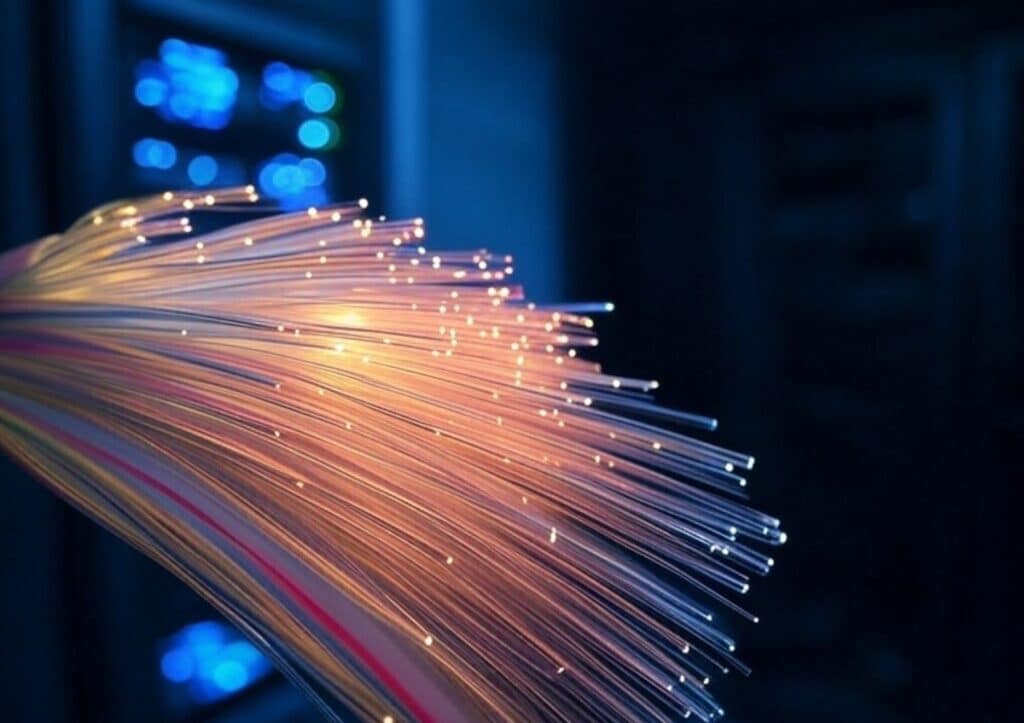Fiber optics is the backbone of modern communications infrastructure. It is critical to backbone links, FTTH networks, data centers, carrier-neutral facilities, and long-haul transport systems. Unlike copper, even small errors during installation can result in significant signal loss or network downtime. This guide provides a step-by-step technical reference for professionals responsible for deploying, terminating, and certifying fiber optic networks.
1. Fiber Optic Types and Classifications
Single-Mode Fiber (SMF)
- Standards: ITU-T G.652D (standard), G.657.A1/A2 (bend-insensitive)
- Core diameter: ~9 µm
- Use case: Metro, long-haul, carrier backbone, FTTH, MMR
- Advantages:
- Extremely low attenuation (<0.35 dB/km)
- Long-distance capability (>100 km)
- Required for high-speed DWDM/OTN systems
Multi-Mode Fiber (MMF)
- Standards: OM1 (62.5 µm), OM2–OM5 (50 µm)
- Use case: Data centers, LAN, SAN (short-range)
- Advantages:
- Compatible with cost-effective VCSEL transceivers
- Simpler alignment for field termination
- OM4/OM5 support 40/100/400G with parallel optics
2. Site Preparation and Safety Measures
Essential Tools:
- Fiber stripper and cleaver
- Jacket cutter
- Isopropyl alcohol (99%) and lint-free wipes
- Inspection microscope or video probe
- One-click cleaner or cassette cleaner
- Fiber disposal unit (glass shards are hazardous)
Safety Best Practices:
- Always wear eye protection and gloves
- Work in clean, dust-free environments
- Dispose of cleaved fiber ends in sealed containers
3. Fiber Optic Cable Types by Environment
| Cable Type | Recommended Use | Notes |
|---|---|---|
| Tight Buffer | Indoor, riser/plenum | Easier to terminate directly |
| Loose Tube | Outdoor, ducted, aerial | Gel-filled or dry-blocked |
| Armored | Underground, industrial areas | Steel-tape protection |
| Breakout | Data centers, racks | Individual reinforced subunits |
| Mini-Distribution | High-density horizontal runs | Light, flexible |
| Direct Buried | Trenches without conduit | Moisture and crush-resistant |
4. Fiber Termination Methods
Fusion Splicing
- Preferred for permanent, low-loss connections
- Requires fusion splicer, cleaver, and heating sleeve
- Typical insertion loss: 0.03–0.08 dB
- Ideal for long-haul, metro, and trunk applications
Field Termination / Connectors
- Common connector types: LC, SC, ST, FC, E2000, MTP/MPO
- Polish types:
- UPC: Ultra Physical Contact (blue) – RL < –50 dB
- APC: Angled Physical Contact (green) – RL < –65 dB
- Installation options:
- Mechanical connectors (fast, higher loss)
- Pre-polished/fusion-terminated for critical links
5. Fiber Management in Data Centers
- Use modular patch panels with LC or MPO interfaces
- MTP/MPO trunks: 12, 24, 48 fibers for parallel optics
- Maintain minimum bend radius: typically ≥10x cable diameter
- Separate optical pathways from copper cabling (per TIA-942-C)
- Use color-coded labels, routing guides, and slack storage
6. Fiber Testing and Certification
Power Meter and Light Source (OLTS)
- Bidirectional measurement at relevant wavelengths
- Typical losses:
- SMF: <0.35 dB per connector
- MMF: <0.5 dB per connector
OTDR (Optical Time Domain Reflectometer)
- Provides event trace for splice loss, reflections, breaks
- Essential for verifying backbone and long-distance runs
- Bi-directional testing for accuracy >150 m
Visual Fault Locator (VFL)
- Red laser at 650 nm
- Detects breaks, excessive bends, or poor splices
- Useful for field troubleshooting and patch testing
7. Installation Best Practices
- Always clean and inspect both ends before connecting
- Maintain consistent labeling and documentation
- Store test results and OTDR traces with project records
- Use pre-terminated or MTP/MPO for high-density needs
- Maintain segregation of tenants in multi-client environments
8. Standards and Compliance
- ANSI/TIA-568.3-D – Optical cabling for structured networks
- ISO/IEC 11801 – International structured cabling
- ITU-T G.652/G.657 – SMF definitions
- EN 50174 / IEC 14763-3 – Field practices and testing
- ANSI/TIA-942-C – Data center infrastructure
- OSHA/ANSI Z136 – Laser and safety regulations
9. Final Field Technician Recommendations
- Plan cabling paths using updated floor plans
- Avoid microbends and stress points during pull
- Record test data and annotate patch panels clearly
- Use bend-insensitive fiber (G.657.A2) in tight spaces
- Refresh training regularly (e.g., FOA, BICSI certifications)
Conclusion
Deploying and certifying a professional fiber optic installation is a meticulous, high-skill task that demands deep technical knowledge and rigorous adherence to standards. From preparing cables to validating connections with OTDR and OLTS, every detail counts. For telecom operators, hyperscalers, ISPs, or enterprise environments, precision in fiber work means robust performance, minimal downtime, and long-term ROI. Skilled technicians are the frontline enablers of the global digital infrastructure.

